|
|
I
recently received a short sample of an interview with famed Tesla
biographer and colleague, Marc Seifer. He describes the deal that
Nikola Tesla made with J.P. Morgan for the wireless communication
across the Atlantic, in the Joseph Sikorsky crowd-funded documentary,
"Tower to the People" in this clip: http://www.marcseifer.com/assets/marc_seifer-clip.mov
For
those interested in more biographical information, the PBS
is a
great and maybe the best one hour show of the life of Nikola Tesla.
Why mention all of this? Well, IRI has received an offer to publish a
grand 250-page resource text on Tesla's wireless power transmission
with all of the world's experts contributing to it,
entitled, Nikola Tesla's Electricity Unplugged which will
be available through Adventures Unlimited Press this Fall. Finally,
the truth about the physics of Tesla's wireless electricity will be
available to the public.
In
other news, Buffalo, NY is the heart of a new venture by Elon Musk
and relatives called SolarCity, the country's leading supplier
of solar panels, to be built on top of the old,
abandoned Republic Steel property just south of downtown. Bringing
its China operations home, it is nicknamed the "gigafactory"
because the plan is to help the US add gigawatts of energy to its
already impressive 18.3 gigawatts of solar power as of the end of
2014. Besides the linked MIT article on SolarCity, there is an MIT
Energy Initiative called "The Future of Solar Energy" from
May, 2015 available online. Want more information? Click here to get a quote from Direct
Energy which supplied solar power for businesses.
Talking
about energy, plan on attending the world's largest conference on Energy Harvesting to be held in Santa Clara
CA on November 18-19, 2015 with 200 exhibitors and
3000 attendees. Energy harvesting is now big business since so much
waste electromagnetic and thermal energy is available everywhere you
look.
This
month we have Story #1 with a short summary of our joint Conference
on Future Energy (COFE) which was the seventh such conference held
this year in Albuquerque NM, along with the ExtraOrdinary Science
conference. Individual DVDs from the conference are
available from our IRI website in case you missed the
first public disclosure of inertial propulsion used on the Space
Station and satellites, inside info on the Papp Engine, and the
latest analysis of Tesla's wireless energy transmission by Dr. Nick
Simos.
Story
#2 gives a new insight into an energy saving use for high voltage
electric plasma. If you see a tractor trailer glowing in the night on
the highway, it is the plasma glow purple reducing drag in a similar
way that Northup and the AF Research Lab has done on military
aircraft to reduce turbulence and induce laminar flow of air.
Story
#3 tells people who wonder how future energy can benefit them now how
to build a small fusion reactor for home use...maybe. With a tenfold
boost in power, an MIT team expect that for the first time, we may
have a high performance fusion reactor soon to provide power for
100,000 people.
Story
#4 continues the latest popular trend of energy harvesting by
describing in detail how to layer flexible electronics to create a supercapacitor
and a solar cell with self-healing abilities. It is the first success
in connecting flexible energy devices directly without using any
conducting wires or circuits.
Story
#5 is a practical article about the new emerging trend in homes and buildings
that produce more power than they consume. Of course, it is in
Germany where there is no limit on how much electricity a person can
sell back to the power company to make money.Heliotrope is the name of one
of the world's first energy-positive homes that can generate up
to five times the power that they need.
Story
#6 uses phase-change material to provide thermal power for cooling in
India. It is unusual that it does not require any electricity input
to work.
THOMAS VALONE
Integrity Research Institute
|
|
|
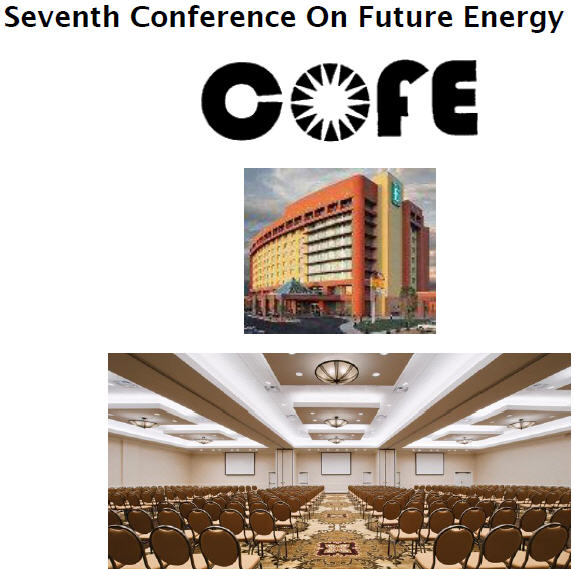
Order yours today!
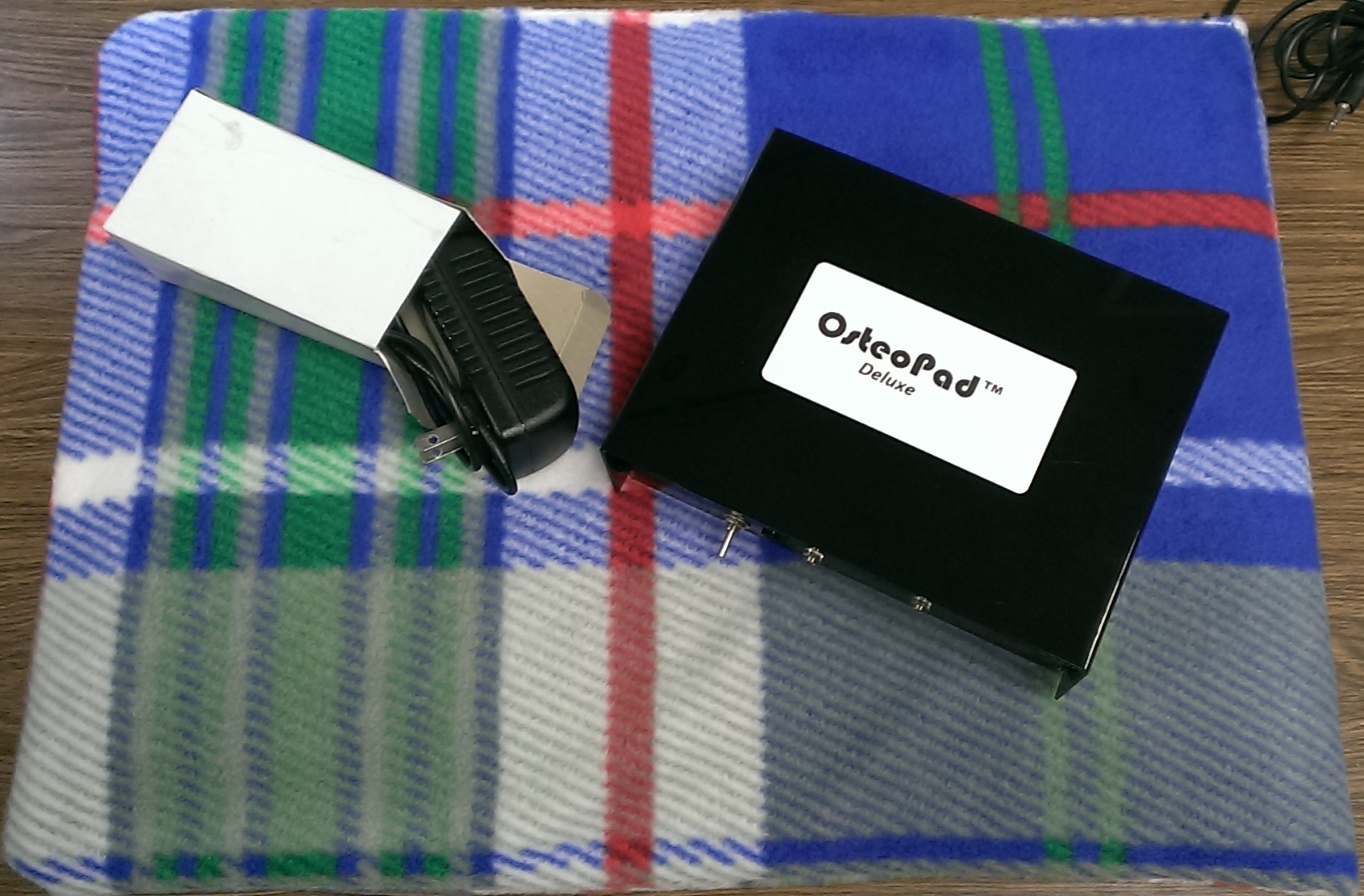
Osteoporosis? Our Newest Item
OsteoPad

EM
Pulser
Our best selling device
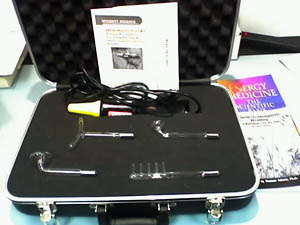
PREMIER
Jr.
Our best selling Tesla coil device
|
|
|
1) COFE7 Conference a Great Success!
|
Integrity Research
Institute Press Release August 2015
The Seventh Conference on Future Energy was held on July
30 through August 1st,
and
featured 14 speakers who presented on a wide array of new-energy
technologies, emerging renewables, advanced future energy
concepts, advanced propulsion concepts and
bioelectromagnetics. This conference was educational, entertaining
and useful to all attendees, which included government, military,
academic delegates as well as energy scientists, entrepreneurs and
inventors from all over the world.
|
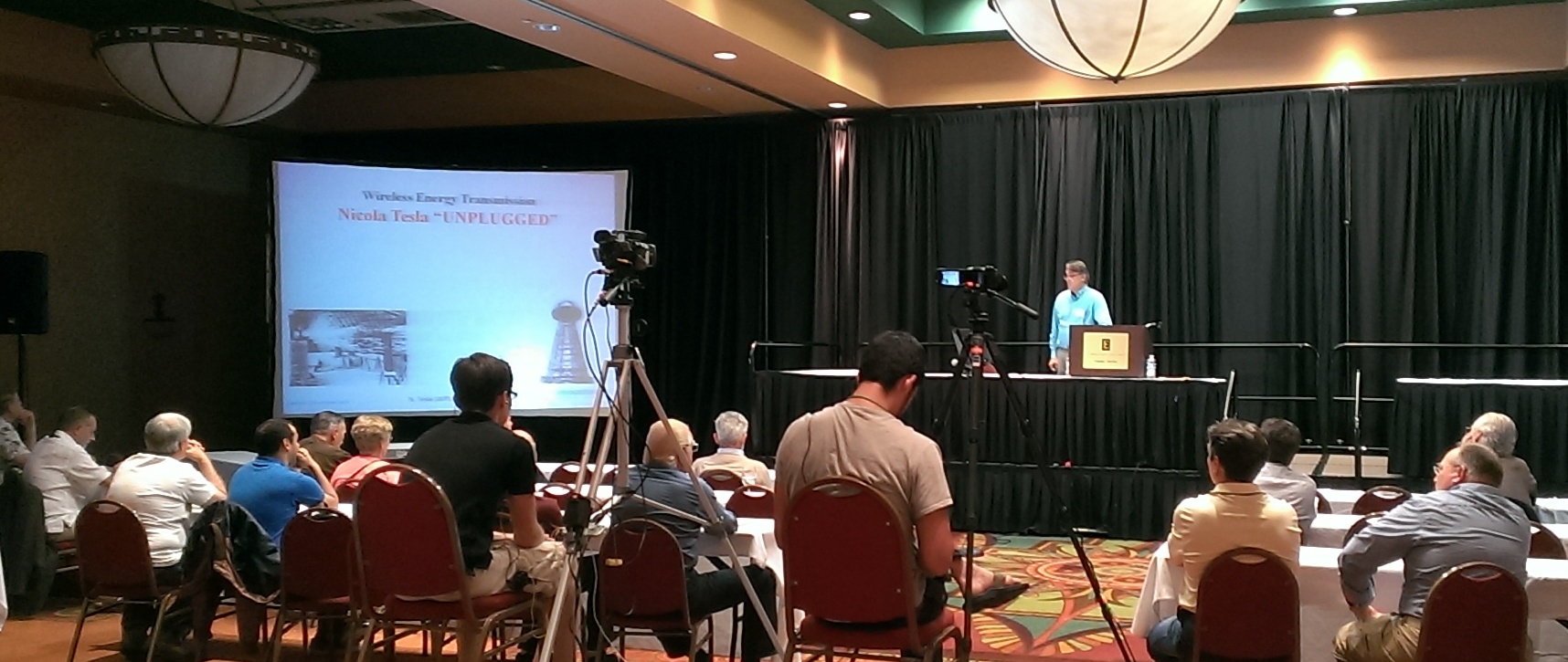
|
|
Dr. Nick Simos Plenary
Presentation at COFE7
|
Integrity
Research Institute (IRI) has the tradition of presenting the best and
latest energy discoveries whether in the technical, environmental,
space and human health areas. These are the hallmark of our
conferences and all of us at IRI were very happy to host our The
Seventh International Conference on Future Energy (COFE7) which provided
the latest developments on Energy, Propulsion
and Bioenergetics with superb speakers together
who traveled far and wide to attend. Our Venue was the
Conference Center at the Embassy Suites Hotel in Albuquerque, New
Mexico. The speakers included an impressive list from many
disciplines and areas such as: Boeing Propulsion and Space
scientists, Aerospace companies, University professors , and private
entrepreneurs.
The morning of
the first day was opened with a presentation by our Institute's
President, Thomas Valone, who welcomed all atendees and gave an
overview of all the presentations. He then presented his talk on
"Latest
Updates on Future Energy Technologies"
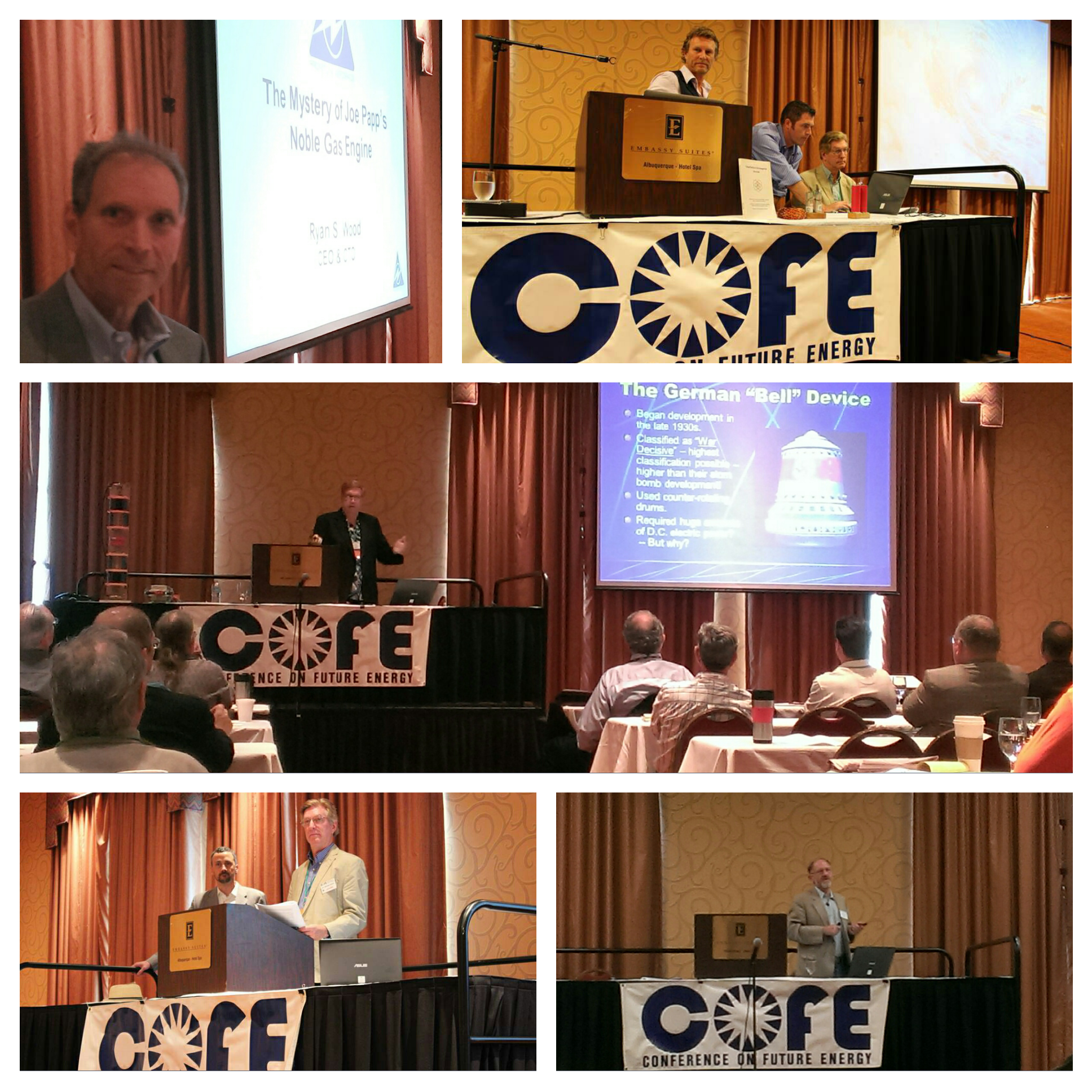 The
following presentation was by Ryan Wood, CEO of Aerospace Com,
presenting on the controversial PAPP Engine, a well researched and
thourough presentation. The
following presentation was by Ryan Wood, CEO of Aerospace Com,
presenting on the controversial PAPP Engine, a well researched and
thourough presentation.
To follow on the same vein, William Alek gave a
excellent presentation entitled: Revealing Antigravity Technology,
with amazing pictures and diagrams of the Bell UFO by Germans in
1940s.
The afternoon presentations opened with Mike Weiner,
giving a amazing presentation on
Stephen Weingandt presented on a groundbreaking
technology that helps with car mileage and water irrigation.
To close the day, Moray King gave his amazing presention
of ThunderClouds and Zero Point Energy.
The next day, the first presentation was by Dr Robert
DeBiase on " Asymmetric Force from Casimir Plate
Experiment", presenting groundbreaking findings on this
intriguing effect.
Following on
Casimir forces, Carlos Hernriques from Portugal presented his
Master's degree Thesis Project: on Casimir Forces and ZPF.
|
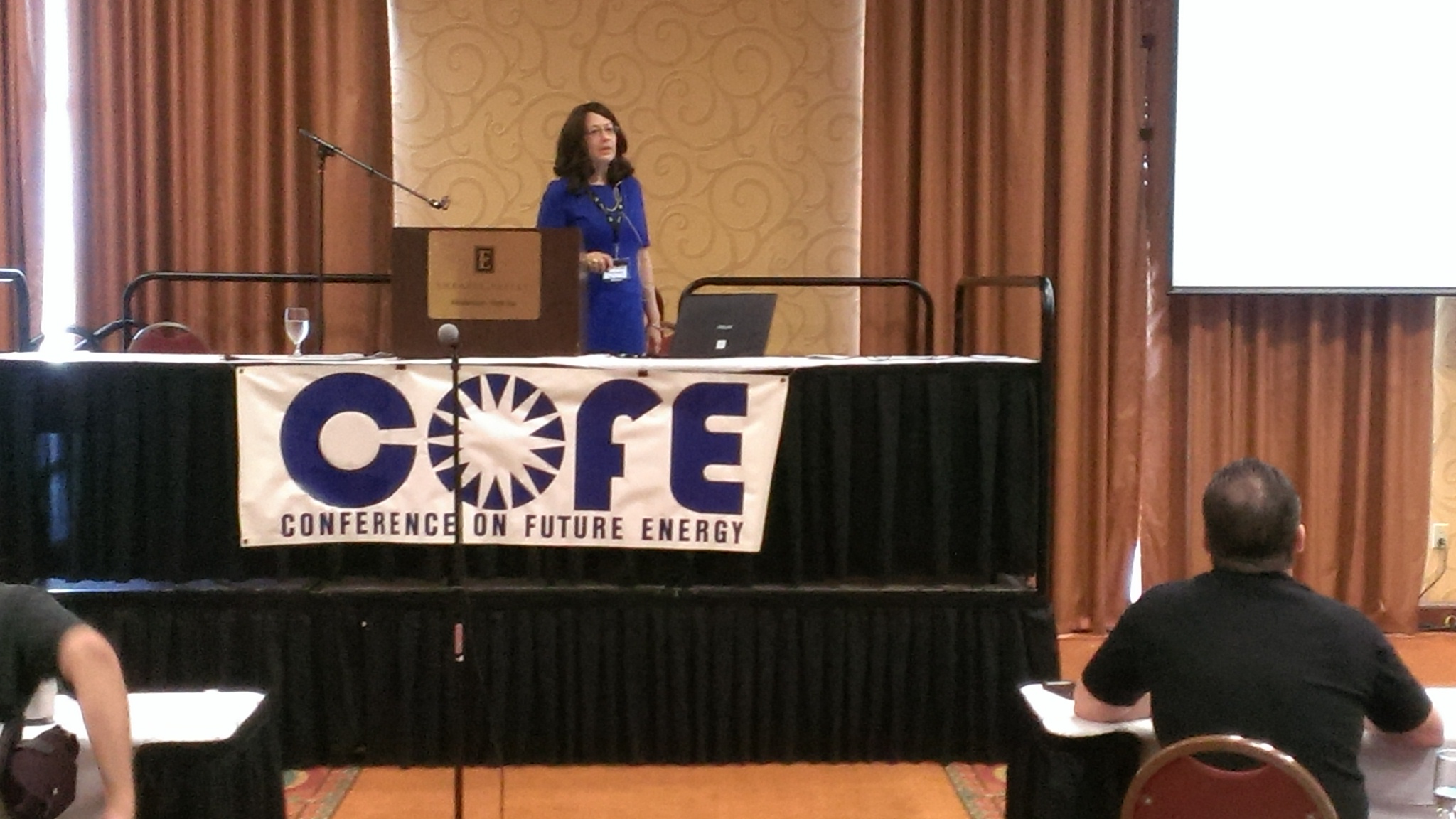
|
|
Dr. Panting presenting her lecture.
|
Then two
entrepreneurs, Marc Cuthbert and Rolland Gregg presented on
the Reid Crystal Cell Vacuum energy Electron Pump of Marcus Reid.
The afternoon
opened with Dr. Thorsten Ludwig, from Germany presenting his latest
findings on the "Single Atom Intention Experiment."
Then, our
Executive Director, Jacqueline Panting presented her bioelectronic
energy talk on "The Importance of NanoSecond Pulsed Electric and
Electromagnetic Fields", showing how the nano second rising is
needed for activating many cells processes, including the 911 repair
protein HSP70 to heal and resolve inflammation at the cellular and
tissue levels. A historical review of Electrotherapy devices was also
given, as well as many scientific papers proving the efficacy of
the PEFs and PEMFs fields, specifically in the nanosecond range.
|
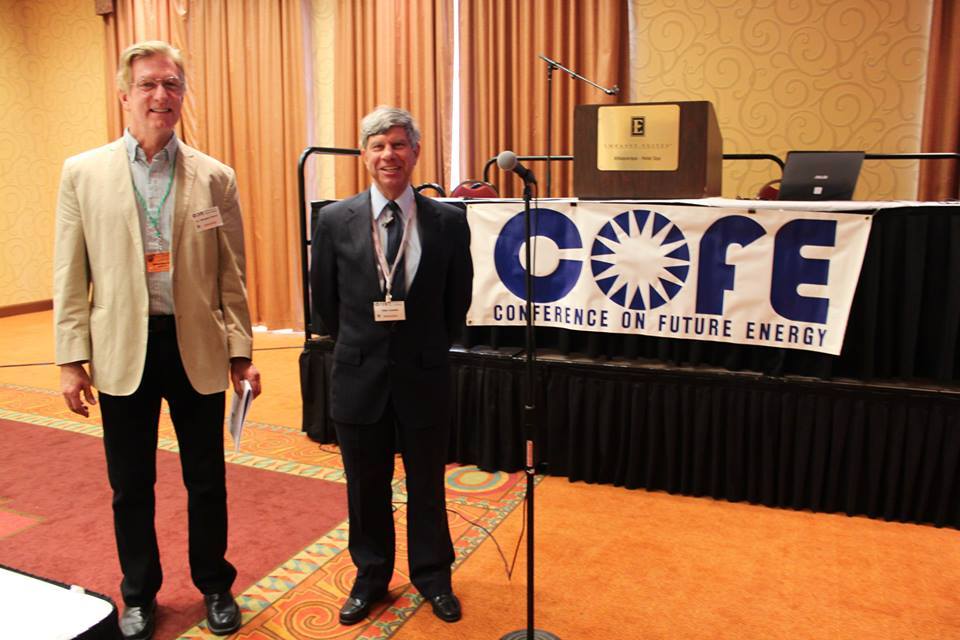
|
|
Dr. Valone and Eng, Mike
Gamble
|
Cloing our event
was the amazing presentation by Mike Gamble, of first public
disclosed use of Gyros and Inertial Propulsion by BOEING, in all
their Space Satellites. IRI has been advocating the use of gyros and
inertial propulsion for the past 2 decades and it was rewarding to
see that they are usable for propulsion, especially in the vacuum.
Mr Gamble who has worked for BOEING for over thirty years, gave
an historical and scientific review of the gyros, presenting pictures
never before seen by the public, many going back to 1960s and 1970s.
All in the crowd were astounded at his revelations.
He gave a second
presentaion as a Joint Plenary on Saturday, disclosing even more
information on space propulsion.
All who
attended COFE7 carried back with them the latest and most
invaluable information on Energy, Propulsion and Bioenergetics.IF you
would like to order the any of the presentations, please order them
on our
|
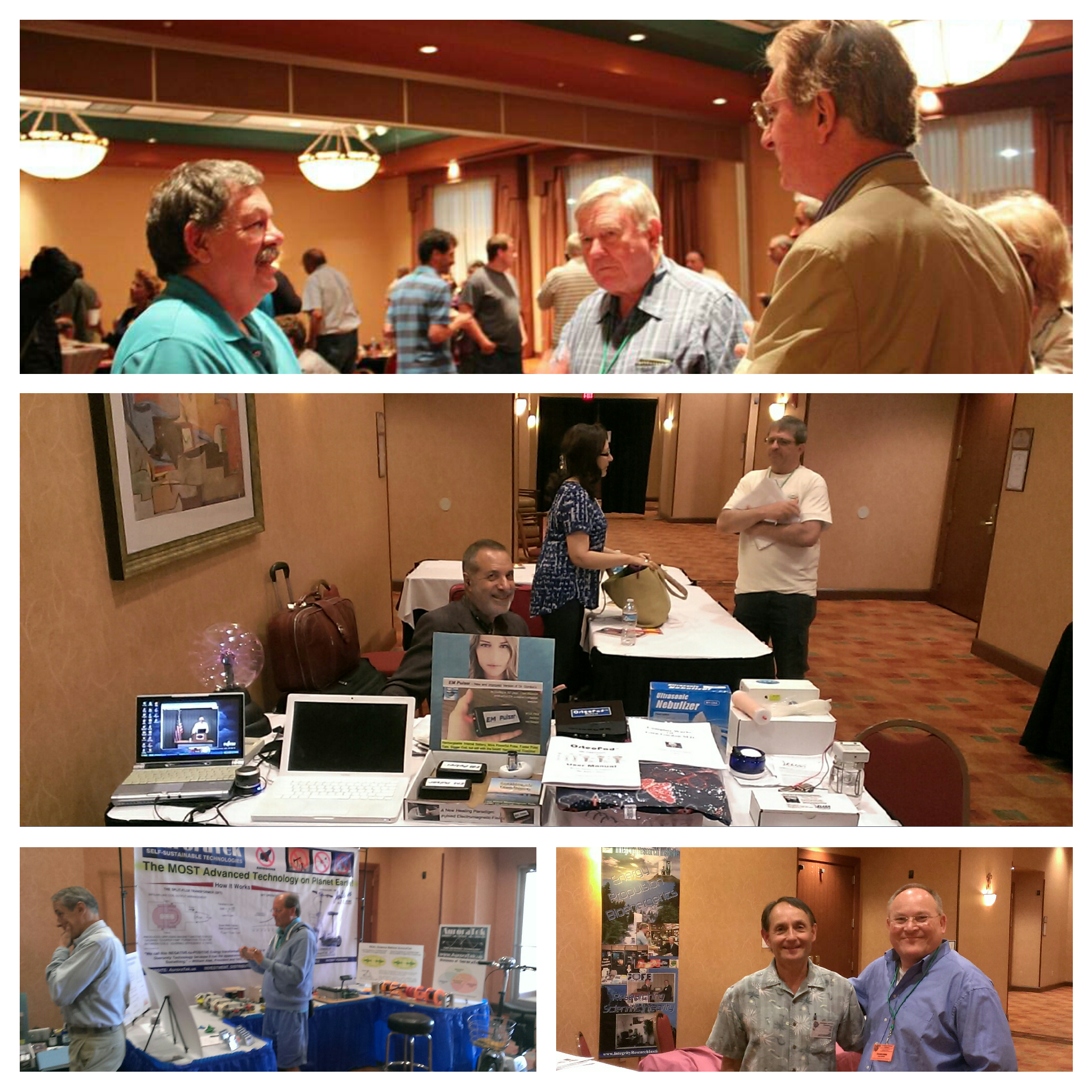
|
|
First
picture shows Dr. Valone discussing the Papp engine with Dannel
Roberts who worked with Josef Papp.
The
next picture shows our IRI booth and that of Elixa Inc. distributors
of many health devices, including our EM Pulser and the Osteopad.
Also
far right is a picture of one of our presenters, Dr. Thorsten Ludwig,
with a COFE attendee,
And the
last picture showing some of the exhibit area at COFE7.
Specify
in comment field, speakers you want to order.
- Thomas Valone PhD - V-Track Spiral Magnet Motor
Development
- Ryan Wood - Detailed Analysis of Papp Engine
- William Alek - Revealing AntiGravity Technology
- Mike Weiner - My Career as Electrodevice
Entrepeneur
- Steven Weigandt MS - New Solutions for Car Mileage,
Irrigation & More
- Moray King - ThunderClouds & Zero Point Energy
- Robert DeBiase - Asymmetric Force from Casimir
Plate Experiment
- Carlos Hendriques - Master's Degree Proj: Casimir
Forces and Zero Point Energy
- Marcus Reid - Reid Crystal Cell Vacuum Energy
Electron Pump
- Dr. Thorsten Ludwig - Single Atom Intention
Experiment
- Jacqueline Panting - The Importance of Nanosencond
Electric and Electromagnetic Fields
- Mike Gamble - History of Boeing's Control Moment
Gyroscope
- Thomas Valone PhD - V-Track Spiral Magnet Motor Dev
(Joint Session with Tesla Tech Conf)
- Nikolaos Simos, PhD - Classical Tesla Wireless Energy
(Joint Session)
- Mike Gamble - State of Art Inertial Propulsion (Joint
Session)
|
2) Plasma
takes Drag out of Trucks and Air travel
|
By David
Hambling, MIT Technology Review, 08-01-15
YOU'RE driving down the motorway at night when you pass
a truck that's glowing purple. Don't worry, it isn't leaking toxic
chemicals: it just has a clever way of reducing drag by using plasma.
Trucks are sometimes fitted with devices such as
spoilers to reduce drag. Panels underneath the body are known as
"side skirts", while "rear tail fairings" are
fitted to the back.
Billions of dollars in fuel could be saved annually if
they were fitted to every truck in the US alone, but the devices have
drawbacks. They sometimes need to be removed for loading, for
example.
"They are only good for one speed range and they
might contribute to drag in other speed ranges," says Pranay
Bajjuri, co-founder of Plasma Stream Technologies in Bettendorf,
Iowa. "They are bulky and the additional weight directly impacts
on fuel efficiency."
So he and his colleagues are working on making trucks
more aerodynamic by using plasma actuators, which would be fitted in
place of spoilers and fairings.
These are essentially two copper plates separated by a
layer of Teflon, developed at the University of Notre Dame in
Indiana, where researchers have been working on trying to reduce drag on aeroplanes.
When a current is passed through the actuators, they produce charged
plasma, which affects airflow. This delays flow separation, where the
airflow detaches from the vehicle's surface and becomes turbulent,
producing drag. The actuators would turn on and off as needed,
controlled by a speed sensor.
Bajjuri claims that a plasma actuator system for a truck
would cost about $2500 and should give fuel savings of around 15 per
cent, paying for itself in months. Actuators don't need to be removed
every time the truck is loaded and unloaded and can even be painted.
The only side effect is the faint purple glow.
"Streamlining a truck with the system will pay for
itself in months. The only side effect is the glow"
The aerodynamics of trucks is bad, says Hyeok-bin Kwon
of the Korea National University of Transportation in Chungju, whose
own work uses plasma to streamline high-speed trains. Fortunately
it's easier to reduce drag on a truck than on a train, he says,
because there are so many are many shape modifications you can use.
Bajjuri's team is working to optimise the system for
trucks before wind tunnel tests later this year.
back to table of contents
|
3) Little
Fusion Reactor Can Power the World
|
By
Maddie Stone, Future Energy, Gizmodo August 2015
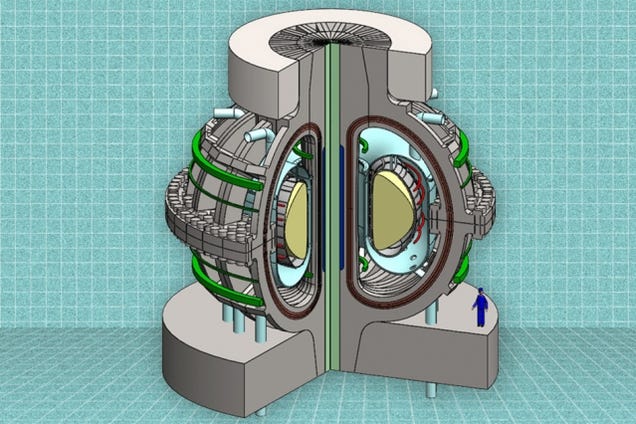 It's
an old joke that many fusion scientists have grown tired of hearing:
Practical nuclear fusion power plants are just 30 years away - and
always will be. It's
an old joke that many fusion scientists have grown tired of hearing:
Practical nuclear fusion power plants are just 30 years away - and
always will be.
But now, finally, the joke may no longer be true:
Advances in magnet technology have enabled researchers at MIT to
propose a new design for a practical compact tokamak fusion reactor -
and it's one that might be realized in as little as a decade, they say.
The era of practical fusion power, which could offer a nearly
inexhaustible energy resource, may be coming near.
Using these new commercially available superconductors,
rare-earth barium copper oxide (REBCO) superconducting tapes, to
produce high-magnetic field coils "just ripples through the
whole design," says Dennis Whyte, a professor of Nuclear Science
and Engineering and director of MIT's Plasma Science and Fusion
Center. "It changes the whole thing."
The stronger magnetic field makes it possible to produce
the required magnetic confinement of the superhot plasma - that is,
the working material of a fusion reaction - but in a much
smaller device than those previously envisioned. The reduction in
size, in turn, makes the whole system less expensive and faster to
build, and also allows for some ingenious new features in the power
plant design. The proposed reactor, using a tokamak (donut-shaped)
geometry that is widely studied, is described in a paper in the
journal Fusion Engineering and Design, co-authored by Whyte, PhD
candidate Brandon Sorbom, and 11 others at MIT. The paper started as
a design class taught by Whyte and became a student-led project after
the class ended.
The new reactor is designed for basic research on fusion
and also as a potential prototype power plant that could produce
significant power. The basic reactor concept and its associated
elements are based on well-tested and proven principles developed
over decades of research at MIT and around the world, the team says.
"The much higher magnetic field," Sorbom says,
"allows you to achieve much higher performance."
Fusion, the nuclear reaction that powers the sun,
involves fusing pairs of hydrogen atoms together to form helium,
accompanied by enormous releases of energy. The hard part has been
confining the superhot plasma - a form of electrically charged gas -
while heating it to temperatures hotter than the cores of
stars. This is where the magnetic fields are so important-they
effectively trap the heat and particles in the hot center of the
device.
While most characteristics of a system tend to vary in
proportion to changes in dimensions, the effect of changes in the
magnetic field on fusion reactions is much more extreme: The
achievable fusion power increases according to the fourth power of
the increase in the magnetic field. Thus, doubling the field would
produce a 16-fold increase in the fusion power. "Any increase in
the magnetic field gives you a huge win," Sorbom says.
While the new superconductors do not produce quite a
doubling of the field strength, they are strong enough to increase
fusion power by about a factor of 10 compared to standard
superconducting technology, Sorbom says. This dramatic improvement
leads to a cascade of potential improvements in reactor design.
The world's most powerful planned fusion reactor, a huge
device called ITER that is under construction in France, is expected
to cost around $40 billion. Sorbom and the MIT team estimate that the
new design, about half the diameter of ITER (which was designed
before the new superconductors became available), would produce about
the same power at a fraction of the cost and in a shorter
construction time.
But despite the difference in size and magnetic field
strength, the proposed reactor, called ARC, is based on "exactly
the same physics" as ITER, Whyte says. "We're not
extrapolating to some brand-new regime," he adds.
Another key advance in the new design is a method for
removing the the fusion power core from the donut-shaped reactor
without having to dismantle the entire device. That makes it
especially well-suited for research aimed at further improving the
system by using different materials or designs to fine-tune the
performance.
In addition, as with ITER, the new superconducting
magnets would enable the reactor to operate in a sustained way,
producing a steady power output, unlike today's experimental reactors
that can only operate for a few seconds at a time without overheating
of copper coils.
Another key advantage is that most of the solid blanket
materials used to surround the fusion chamber in such reactors are
replaced by a liquid material that can easily be circulated and
replaced, eliminating the need for costly replacement procedures as
the materials degrade over time.
"It's an extremely harsh environment for [solid]
materials," Whyte says, so replacing those materials with a
liquid could be a major advantage.
Right now, as designed, the reactor should be capable of
producing about three times as much electricity as is needed to keep
it running, but the design could probably be improved to increase
that proportion to about five or six times, Sorbom says. So far, no fusion
reactor has produced as much energy as it consumes, so this kind of
net energy production would be a major breakthrough in fusion
technology, the team says.
The design could produce a reactor that would provide
electricity to about 100,000 people, they say. Devices of a similar
complexity and size have been built within about five years, they
say.
"Fusion energy is certain to be the most important
source of electricity on earth in the 22nd century, but we need it
much sooner than that to avoid catastrophic global warming,"
says David Kingham, CEO of Tokamak Energy Ltd. in the UK, who was not
connected with this research. "This paper shows a good way to
make quicker progress," he says.
The MIT research, Kingham says, "shows that going
to higher magnetic fields, an MIT speciality, can lead to much
smaller (and hence cheaper and quicker-to-build) devices." The
work is of "exceptional quality," he says; "the next
step ... would be to refine the design and work out more of the engineering
details, but already the work should be catching the attention of
policy makers, philanthropists and private investors."
The research was supported by the U.S. Department of
Energy and the National Science Foundation.
|
4) Energy
Devices Go Wireless
|
By
Energy Harvesting Journal, August 2015
Scientists in China have
developed a new method for connecting energy devices without using
wires. Not only are the devices easy to make, they continue to work
even when bent or twisted - a vital trait for flexible electronics.

Traditionally, energy devices involve modules connected
in a series by electrically conducting wires. Although this is the
standard system, fabricating such devices is complicated and costly,
and the risk of short circuits means these devices also pose a serious
safety hazard.
These difficulties are well understood by Hao Sun, a
scientist at the Fudan University in Shanghai, China. Sun used to
make flexible electronics in the conventional way: 'I found the
connecting process quite time-consuming and complex, as well as the
sacrifice of the flexibility and integrated level of the resulting
module,' he says.
This drove Sun and his co-workers to come up with a
better way of connecting modules - by combining electrically
conducting carbon nanotube sheets with a self-healing polymer.
Overlapping the edges of the modules then pressing
them together initiates hydrogen bonds in the polymer to fuse the
molecules together. This fusing process, which takes only a few
seconds, connects carbon nanotubes in the different modules, allowing
a current to pass between them.
Sun says this work "represents the first success in
connecting flexible energy devices directly without using any
conducting wires or circuits". The team showed the practicality
of their approach by applying the system to supercapacitors as well
as solar cells.
In the future, they hope to design further fusible
sensors to fabricate self-powered devices with various functions.
Keon Jae Lee, an expert in energy devices at the Korea Advanced
Institute of Science and Technology (KAIST), says "this new
technique could be applied to the latest electronics including
portable, flexible, and wearable devices as a simple and efficient
connection tool".
|
5) Solar
Powered Buildings that Produce More Energy than They Use
|
By
Cat DiStasio, Engadget Magazine. August 12, 2015
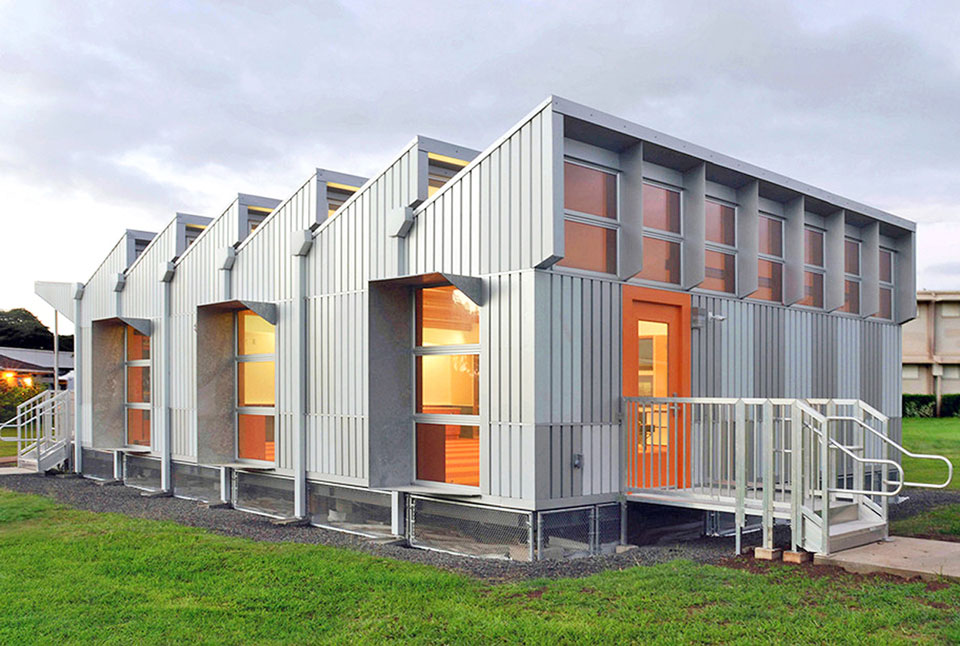
As the cost of solar
energy falls, more and more
buildings are being outfitted with photovoltaic systems -- and some
even generate more electricity than they use. Structures like that
are called "energy positive" and it's a pretty impressive
feat. If your home or business can produce more power than it needs,
it can actually turn a profit, since local utility companies can buy
that excess electricity from you and feed it into the grid for others
to use. We've rounded up some of the most incredible energy-positive
buildings from around the world -- read on for a closer look.
The spinning, sun-chasing Heliotrope
Our first stop is an amazing and eye-catchingsolar home in Germany designed by
Rolf Disch. The aptly named Heliotrope is one of the world's
first energy-positive homes, and it can generate up to five times as
much power as it needs to operate. The home sports a giant angled
solar array on the roof and the entire structure is mounted on a pole
timed to rotate 180 degrees each day as it follows the sun.
Australia's first carbon-positive homeDesigned
by architecture firm ArchiBlox, theCarbon Positive House is a green
dream that features passive heating and cooling as well as smart
approaches for recycling rainwater. And it's not just impressive
because of its energy-positive status, but also because it's a
prefabricated building. Measuring just 800 square feet, it combines eco-conscious
design with a cozy, contemporary interior where residents can enjoy
the cool air pumped in from the shaded south side of the home. This
one's just a prototype, but we're eagerly awaiting the day when a
home like this can be ordered and built anywhere in the world.
The
world's first energy-positive office
When it opened in 2009, the Elithis
Towerbecame the first office building of
its kind to generate more energy than it consumes. Located in Dijon,
France, it's a 10-story structure with an oval shape and a swooping
solar shield that wards off the blistering sun to keep the
temperature inside comfortable. Not only is the tower energy positive
thanks to its 330 rooftop solar panels, but it's also friendly to our
atmosphere since it produces six times lessgreenhouse
gas emissions than the average
office building of the same size. Arte Charpentier Architects
designed it as a theoretical challenge and managed to keep costs
within a $10 million construction budget.
Sun-powered
off-grid classroom Students in this
portable classroom are learning
about more than reading and writing: They're getting a lesson in
renewable energy. The sunny state of Hawaii is the perfect spot for a
solar-powered modular unit like this, which replaces the outdated and
inefficient mobile classrooms of yore. This prototype is designed to
generate four times more electricity than it needs whileminimizing
energy use with natural ventilation and
occupancy sensors on lights. The state is planning to replace some
10,000 portable classrooms in the coming years, so just imagine the
staggering energy savings that could come from solar-powered
solutions like this one.
German
solar city produces four times more energy than it uses
Finally, as if all these individual buildings weren't blowing your
mind with their ability to feed electricity back to the grid, German
architect Rolf Disch one-upped them all by creating an entire solar
city. Sonnenschiff in
Freiburg is a small community that is entirely powered by the sun,
with rooftop solar panels everywhere you turn. Combined with Passivhaus principles
that utilize energy efficiently, the city can generate up to four
times as much electricity as it needs. Sonnenschiff includes a
neighborhood with 52 private residences, as well as several buildings
with commercial and residential space. Way to go, Germany!
|
6) Thermal
Batteries Provide Cooling Power
|
By
Richard Martin, MIT TECHNOLOGY REVIEW August 2015
Sometime this week a large milk refrigerator will arrive
in Dhaka, the capital of Bangladesh. Since Bangladesh produces nearly
four million tons of milk per year, that hardly seems remarkable; but
this is a special kind of refrigerator.
Made by Promethean Power Systems, a company
based in Pune, India, and Boston, the system keeps milk chilled with
a thermal battery that stores energy and releases it, as cooling
power, over the course of a day. Like India, Bangladesh has an
outdated power grid that supplies electricity sporadically-often as
little as a few hours per day. Rural dairy farmers on the
subcontinent bring their milk to village collection centers that
typically rely on diesel generators, a costly, dirty way of providing
electricity.
 Two
Americans, Sam White and Sorin Grama, founded Promethean Power in
2007 to address a simple but widespread and pressing problem: how to
keep milk cold without burning diesel fuel. They've been selling
refrigerators in India for two years; this week marks their first
export to neighboring Bangladesh. Two
Americans, Sam White and Sorin Grama, founded Promethean Power in
2007 to address a simple but widespread and pressing problem: how to
keep milk cold without burning diesel fuel. They've been selling
refrigerators in India for two years; this week marks their first
export to neighboring Bangladesh.
"We've been at this for eight years," says
White, and "we've gone through all sorts of different technologies,
attempts, and failures to figure out a solution."
At first, he says, they were determined to craft a
technology that relied on solar power-a noble attempt that ultimately
failed because solar power, like grid power in India and Bangladesh,
is by its nature intermittent, and refrigerators need constant power.
Eventually they settled on a thermal energy storage system that uses
a phase-change material to store energy in the form of ice. When the
grid is operating, a portion of the material freezes, and the battery
circulates that thermal energy into a heat exchanger to keep milk
chilled over the course of the day. The thermal battery can store up
to 28 kilowatt-hours of energy.
"We're not delivering new forms of energy; we're
simply storing the intermittent power that they do get and parceling
it out over time," says White. Promethean Power has sold around
150 systems in India to date. The dairy collection center in
Chetawala, in the state of Rajasthan, estimates that it saves around
40,000 rupees ($628) a month on diesel fuel and reduced milk spoilage
since installing a Rapid Milk Chiller from Promethean Power. The
center has increased its average daily milk production from 500
liters a day to around 800.
That's a huge improvement in a country where more than
300 million people live without access to electricity and even
villages that are nominally electrified often have spotty service at
best. Prime minister Narendra Modi, who took office last year, has
pledged to bring reliable electricity to the full population by 2022.
|
About
Integrity Research Institute
Future Energy eNews is provided as a public
service from Integrity Research Institute, a Non-Profit dedicated
to educating the public on eco-friendly emerging energy technologies.
FREE
copy of
the 30 minute DVD "Progress in Future Energy" is
available by sending an email with "Free DVD" in
subject and mailing address in body.
Your generous support is welcome by making a tax
deductible donation on
our secure website
|
|
|
|
|
|
![]()


























